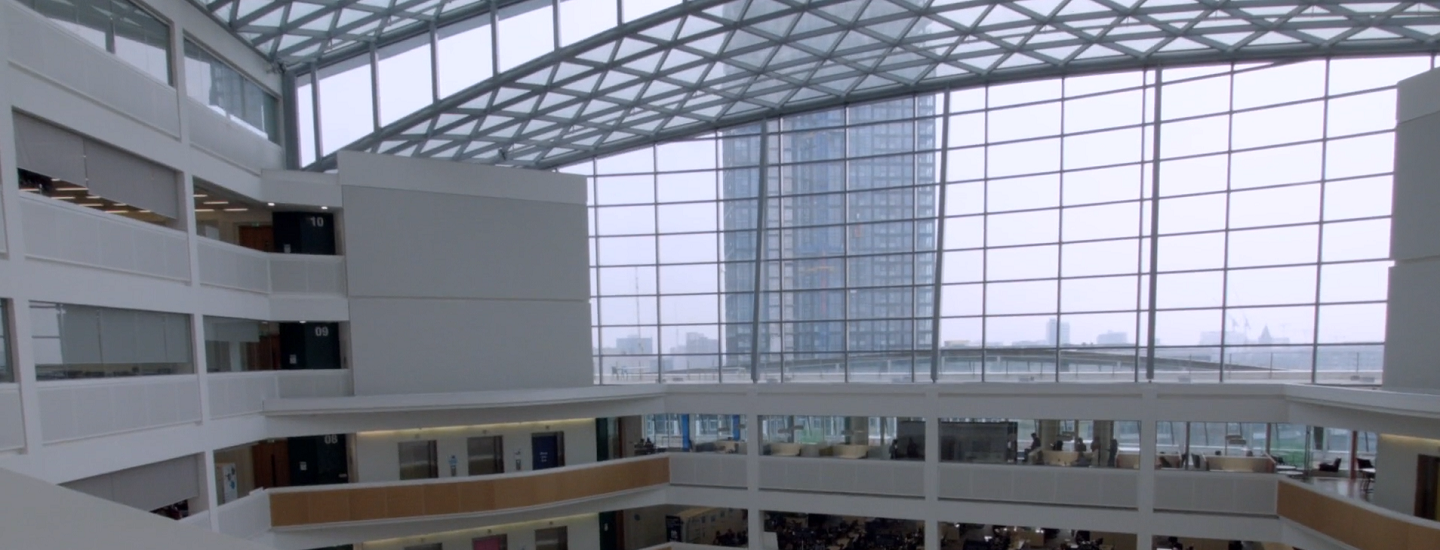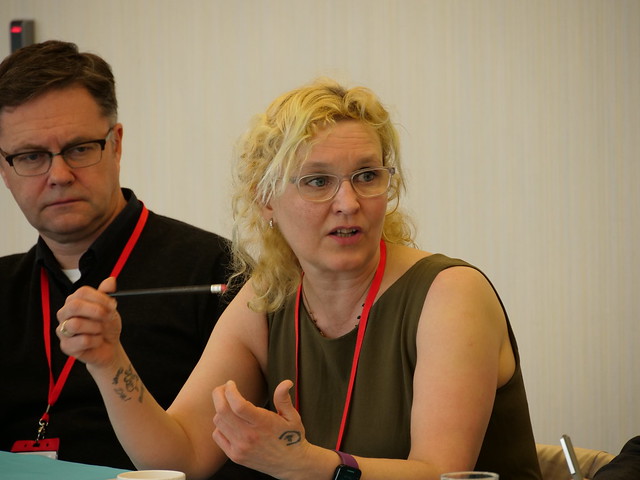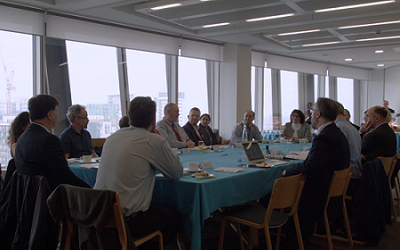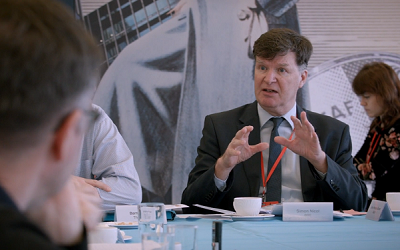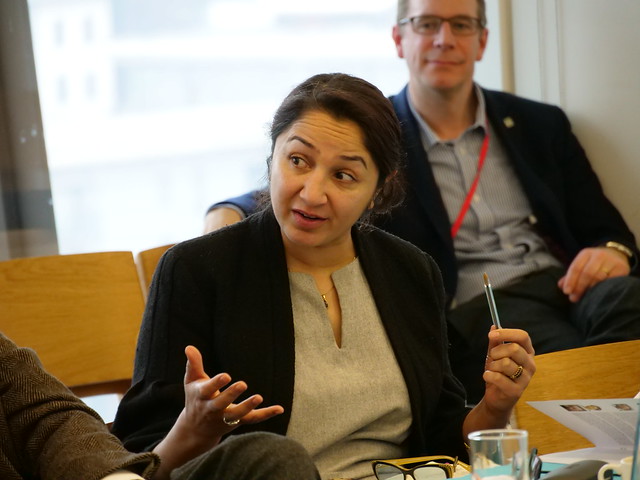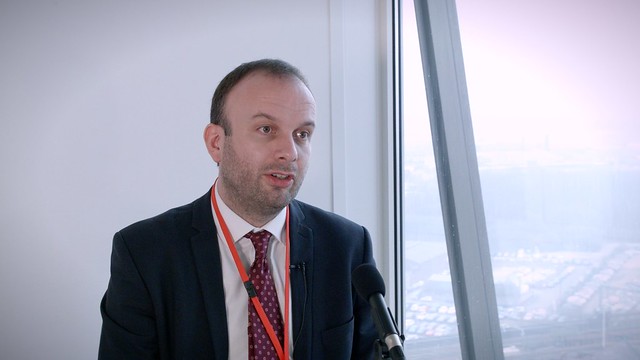The third in the series of BRE’s “Frameworks to build a better Britain” roundtables took place at one of Manchester’s most impressive new buildings, the Co-op’s new HQ at 1 Angel, a powerful symbol of the city’s vigorous rejuvenation over the last three decades.
The theme for this roundtable discussion was “How can Britain’s built environment tackle social exclusion?” When it was launched by the Blair government in 1997 the Social Exclusion Unit worked with a definition. Social exclusion is “What can happen when individuals or areas suffer from a combination of linked problems such as unemployment, poor skills, low incomes, poor housing, high crime environments, bad health and family breakdown.”
Frameworks to build a better Britain
The third in our Frameworks to build a better Britain series of articles and podcasts: roundtables and interviews with planners, architects, policy-makers, and construction experts. Explore the first and second roundtable events in this series.
The roundtable was opened by Niall Trafford, the CEO of BRE. “We’re focused on quality and impact in housing and the wellbeing it should lead to. Our aim with these roundtables is to go out around the country and listen to those we don’t normally interact with. To get out of the London bubble in order to understand and learn more in order to make BRE fit and relevant for the future. We’re here to talk and share and learn.
“It might not appear that social exclusion comes within our remit but that isn’t the case. For example, how are we going to ensure that the hundreds of thousands in our society who continue to suffer heat poverty can be kept warm during our winters? We have done extensive research in this area. Around 11% of English households are fuel poor. 65% of English homes could benefit from energy efficiency improvements.”
Niall’s podcast interview is here:
Just over 200 people lived in central Manchester in 1983 and that number is now between 30-40,000. It was named by Deloitte earlier this year as one of Europe’s fastest growing cities.
There’s certainly a worry that the city’s economic strengths are not being converted into inclusive growth. The largest share of the £1.6 billion post-Brexit boost announced by the government in early March 2019 went to struggling towns in the North-West.
There are mounting concerns about the widening divides between the Haves and the Have-nots. Some 10,000 apartments are currently being built in Manchester city centre and another 9,000 are expected in the next three years. By contrast, rough sleeping is on the rise throughout the UK but the biggest regional increase is in the North-West where numbers have almost doubled over the past two years and quadrupled since 2010.
Three areas in Greater Manchester have been named among the poorest in England. Half a million are income deprived, according to the Joseph Rowntree Foundation and one in four children still live in poverty. Despite its own rules, in the last two years, none of the 14,667 homes in large developments that were granted planning permission by the council’s planning committee, are set to be “affordable.” This is what has become known as “The Manchester Paradox.”
Further background to the roundtable was a recent report by Shelter which called for more than three million new social homes to be built over 20 years to solve Britain’s housing crisis. The report concluded that an extra 1.27 million homes are needed for those in the greatest need, including homeless people, those with a disability or long-term illness, or those living in very poor conditions.
Former Treasury minister – and one-time Goldman Sachs partner – Lord Jim O’Neill is one of the Shelter commissioners.
He said: “There needs to be a profound shift to see social housing as a national asset like any other infrastructure. A home is the foundation of individual success in life, and public house-building can be the foundation of national success. It is the only hope the Government has of hitting its 300,000 homes a year target.
“The Government’s budget for capital expenditure is £62bn a year – our house-building programme would cost only a fraction and is well within its financial reach. With current spending on housing benefit shockingly inefficient, it’s not hard to see what an investment in bricks and mortar could do to help solve the housing crisis and boost our economy.”
There was no better representative to open a discussion about social exclusion and the failure of the housing market than Antony Lockley, the Director of Strategy and Assistant Chief Executive at Blackpool Council. Blackpool’s difficulties have led it to become the unfortunate poster child for social exclusion in the UK.
Blackpool is the most unhealthy place in England and poor housing is also at the centre of the town’s poor health. Its 4,000 disused guesthouses have over recent decades been bought up by private landlords to profit from housing benefit claimants who are often crammed into houses of multiple occupation.
“Quality is just as important as quantity when it comes to housing in the North,” said Lockley, “And Blackpool shows there is a tight relationship between that quality and social inclusion and exclusion. Despite recent growth, we’ve seen a significant contraction of our primary industry – tourism – since the 1970s and that has led to a huge legacy of redundant buildings – old B&Bs and hotels primarily. In the last 30 years those spaces have become housing benefit farms with private landlords chasing yield via houses in multiple occupation.
“Landlords are incentivised by the benefits system to subdivide these properties, assisted by a lack of effective regulation and low statutory standards.
“We’ve experienced a permanent migration of vulnerable people to Blackpool, in particular from the big cities like Birmingham, Burnley, Manchester and Glasgow. In our inner eight wards, over fifty per cent of our housing is poor quality for private renters – a startling statistic. However, there is no relationship between rents paid by public subsidy and the quality of the product on offer. This dynamic, and the perverse incentives on offer for landlords to cram vulnerable people into poor quality accommodation, has led Blackpool to become the single most deprived place in the UK under any single measure of deprivation.
“Some parts of many towns and cities across the North now require wholesale clearance and re-modelling. We need a localised system of public subsidy that rewards quality and investment rather than incentivises failure.
We are doing everything we can within the law in Blackpool to regulate this housing failure. However, the cost of intervention is prohibitive. We can buy property using our cheap borrowing powers over thirty years which means for every £200,000 borrowed at 2% we can create three quality apartments out of a failing house in multiple occupation. But we need the private sector to be incentivised to make similar kinds of investments. In the end, the aim is to have a housing stock that supports individuals and families in putting down roots, stabilising their lives, and contributing to a sustainable community. Right now in inner Blackpool we have exactly the reverse.”
The second speaker was Daniel Cochlin, Head of External Affairs at the Northern Powerhouse Partnership. “The Northern Powerhouse has called for £39 billion for investment in an improved East/West rail network,” said Cochlin, “And we’re also calling for a £250 million housing fund to cater for the predicted growth around the areas of transport expansion including HS2.
“The economic growth delivered by linking up the great cities of the North could deliver 850,000 new jobs by 2050 and will mean more housing is needed – probably 50,000 new homes each year – and its vital that it’s inclusive.
“We don’t want to create new Londons and we know that Manchester’s boom has led to an increase in rents of 30% over four years. That’s not necessarily a good thing. We will need a mix of social rent and private sale. Affordability is key.
“Devolution is the key to unlocking the full potential of the Northern Powerhouse and we’re strongly supportive of elected mayors. Locally elected officials are far better placed to deliver what we need when it comes to housing, transport, education and many more critical areas. It’s only with local decision making that the problems can be properly addressed. It’s not just Manchester that has been transformed by redevelopment of its built environment – Liverpool has been reinvigorated in a similar way.”
Risha Lancaster has wide and direct experience of the sharp end of social exclusion as the founder of Coffe4Craig which provides help, food, advice and a shower for Manchester and Salford’s rough sleepers. She lost her brother Craig, who was homeless, to a heroin overdose.
Risha made the point that insecurity of employment was a major contributor to social exclusion. “Trying to rent with a zero-hour employment contract is impossible – you just cannot secure a tenancy, let alone a mortgage. These homeless people need not just housing, but community spaces where they can help themselves.”
Risha’s podcast interview is here:
Amina Lone, Co-Director of the Social Action and Research Foundation said “I feel so frustrated when the conversation is about bricks and not people. It’s not just about houses, it’s about communities. I live in Gorton, one of the most deprived communities in Manchester. There are simply no facilities there. The infrastructure is awful – no tram, just buses. We lost our last bank and the only shops are now tanning, betting and pawn businesses.
“I sat as a Councillor on Manchester City council and we had massive and endless debates but you cannot say ‘social housing’ in certain parts of that organisation. They don’t want it. And at the end of the day developers want profit.
“The other important factor is that in-work poverty is getting worse. People are working but they cannot afford to pay the rent. There is much talk about affordability, but affordable for whom?”
Amina’s podcast interview is here:
The question of development and social value came up repeatedly. Social value in development is often a hard concept to nail down – something that most people accept is a desirable thing but often hard to define and quantify. But Jane Healey Brown who leads Arup’s Planning, Policy and Economics team across the North West and Yorkshire thinks the subject requires proper research and evaluation.
“I’m increasingly concerned that the mechanisms we have don’t allow for proper consideration of social value and with Brexit looming we lose access to EU decision-making which does allow for it. We must change our structures and decision-making to unlock opportunities that would lead to inclusive growth. At Arup we’ve been looking at what social value means and trying to establish metrics. We have people doing PhDs on the subject including one individual who previously worked inside the Treasury. What’s encouraging is that we are starting to see some major private sector investors leading the way on this approach – there’s a need for the public sector to catch-up.”
“We could have lots of money to build and lots of land on which to put those homes,” he said, “But we really need the right culture within the construction sector to deliver on quality. If you don’t have that, we are going to fail. The housebuilding sector isn’t perceived well by the public. Why is it that over forty percent of people when asked in a 2016 YouGov survey commissioned by the HBF, say it’s unlikely that they’d consider buying a new build home?
“Our biggest housebuilder, Persimmon, has come in for criticism for poor quality despite benefiting from government money via the Right To Buy scheme. The opportunity to get things right with new homes isn’t quite happening. Government must ensure that where it spends its money, it helps the housing sector overall, and that means getting the basics right for all.
“There is some forward thinking within government especially around the NHS. Its 10-year plan demonstrates a realisation that it should have a say in the housing that is being built. BRE has long made the connection between the cost of healthcare and poor housing. We now need to think about this positively with new homes so that they will not be the “poor housing” of the future.
“I also think there are some real risk areas with current delivery. The permitted development of office to residential has seen some plans come through that are appalling and you just know they are going to be the poor housing in ten years’ time that will need something to put them right.
Gwyn’s podcast interview is here:
A worry about construction standards was echoed by Shelagh McNerney, Head of Development at Salford City Council until the end of March: “I’ve been in the industry for 30 years and worked around many private and public sector roles – you might say – on both sides of the development fence. Devolution on its own isn’t the answer. The whole construction industry, the investment sector (which includes the large sums of foreign money) and the whole development industry are part of this. The Government faces big questions about our economy as it has underperformed for decades. This is not inevitable.
“There are real opportunities in the built environment but we also have a skills crisis – there aren’t enough people to build what we need – even if we can garner the finances. I think we need to be thinking along the lines of the United States in the 1930s and a New Deal. This would involve not only more public and private sector investment, but also The Industrial Strategy to get serious about the construction sector and associated built environment investment and all that implies about our low levels of productivity. It’s not just about construction though: the built environment is about maintenance of the public realm and our infrastructure. It could be a brilliant sector to be in. It’s simply a matter of translating that goodwill and what can appear as wish lists including social value into actual practical delivery on the ground. If we did it before we can do it again. We will always need to build and re-build.”
There was considerable worry around the table about the planning system and the need for radical reform of building regulation. “There simply aren’t the qualified and skilled people making planning decisions inside local authorities anymore,” said one participant. “The cuts have taken their toll. And developers will do all they can to wriggle out of their responsibilities. You squeeze out a bit more profit by building over promised communal gardens because that way you can get a couple more units in.”
David Roberts, a director at Igloo, a sustainable urban regeneration specialist noted:
“We talk about place: the benefits to all if we focus on delivering a quality place. Some projects are successful in doing this, but in terms of housing supply we know that the vast majority do not even attempt it. Housing is by a massive margin delivered by those who exit way before occupation. Even after-care is dealt with by insurance policy rather than by actual caring. Change is needed throughout the supply system if we are going to deliver quality places to live work and relax. That means from the starting point of land sales (local authorities, Homes England, private landlords and their army of advisors – RICS, etc) through to planning, financing, designing, constructing and managing.
“Progress is possible and is now evident, albeit in the margins. We and a few others follow self-imposed regulations and policies with the aim of delivering the best possible developments. For example, BRE’s Home Quality Mark and the Building For Life benchmarks are being ingrained within Igloo’s Footprint® approach to development to help ensure that objectives relating to sustainability and quality are being achieved and robustly monitored.
David Rudlin is a director of URBED (Urbanism Environment and Design). He has lived and worked in Manchester for several decades and has been responsible for flagship renewal schemes in the city. He won the Wolfson Economics prize in 2014.
“Even in the strongest economies there will always be deprived groups; people who fall through the net,” he observed, “And we have never solved the problem of how to house them. I cut my teeth in Hulme, which was then the biggest council estate in Europe. Hulme has now been re-developed and it’s fair to say that it’s much less deprived now. It’s no longer the place where Manchester’s poor end up, as we just heard, maybe they now end up in a former B&B in Blackpool.
“To a certain extent that’s because the original community have been replaced by home owners. But there’s a more subtle story. We built 2000 social houses in Hulme and the stability that comes from giving people a good home allowed them to improve their circumstances. Many of them are still there and it is the stability of the community that limits opportunities for new people to move in.
“The answer to how we house deprived communities is, of course, council housing, it always was, despite the terrible mistakes that we made in the 1960s and 70s. Council housing that serves a wide range of people and doesn’t put all of the most deprived people in the same place. This is a lesson we need to relearn.”
There was a majority agreement that more social housing was now badly needed in Britain. However, the price of land in the UK might make this difficult. Between 1945 and 1980 an average of 125,000 new social houses were constructed each year. The sale of council houses then began under Margaret Thatcher and the numbers have not been replaced. In 2018 6,500 council houses were built.
The issue of the high price of land came up repeatedly. “Buy land,” wrote Mark Twain, “They’re not making it anymore.” Since 1995, in the United Kingdom the total value of land has increased by more than 500%. According to the Valuation Office, whereas the average price of agricultural land in England is £21,000 per hectare, the same patch with planning permission for housing can fetch an extraordinary £6 million. Impossible land prices cut-out developers beyond the small handful of giants who dominate the market.
Several participants endorsed the proposals put forward by Sir Oliver Letwin in 2018 which called for the state and local authorities to be able to “capture” more of the increase in value of sites when they are granted planning permission. This would enable local authorities to seize greater amounts of landowners’ profits in order to fund the construction of local infrastructure such as roads and affordable homes.
Letwin’s review called for this ‘with permission’ value to be “capped” at 10 times the existing use value, rather than any multiple of its existing value as often occurs currently.
“It’s hard to see what you are going to do about high land value,” said one panelist. “Unless you have a communist coup that nationalises the land. The reality is we’re dealing with private land ownership throughout. And, anyway, profit isn’t a dirty word. Businesses have improved this city over the last twenty- five years. The best social benefit is to be employed and the fantastic story of Manchester is its improvement in business base through massive structural change.
Objectively, people’s chances are better than 30 years ago – where were the jobs then? But it’s true that it’s impossible to see social value when sites are just flipped between developers, six million pounds has changed hands and then when they come back to planning suddenly they cannot afford balconies. There is more we could do to resist this kind of practice.”
Finally, Simon Nichol of BRE provided some statistics on UK housing to give the discussion some evidence-based perspective:
- The UK has the oldest housing stock in Europe and, most probably, in the world. Some 37% of our homes date from before 1939, compared to 24% in Germany and Sweden, and 9% in Finland.
- There is a strong correlation between the age of the housing stock and its quality, performance and condition. Some 11% of UK housing is of ‘poor quality’, the average for the EU. This compares with 2% for Denmark (which has the best quality housing in the EU), 4% for Finland and 5% for Sweden and the Netherlands.
- The North West has the oldest housing stock of English regions and some of the poorest housing conditions.
- The private rented sector has the oldest and poorest condition housing of UK tenures. The highest number of vulnerable people in poor housing are owner-occupiers.
- Social housing has the highest level of over-crowding, as social mobility is strictly limited. Some 8% of social housing is overcrowded compared to 1% of owner-occupied housing. Children being brought up in over-crowded homes under-achieve at school compared to those who have their own bedroom.
- Housing is measured through the Housing Health and Safety Rating System (HHSRS). Some 18% of England’s housing contains a Category 1 HHSRS hazard (as measured through the English Housing Survey 2015), which means that it is unacceptable for a vulnerable person to live there. It is estimated that leaving people to live in such housing environments costs the NHS some £1.4bn per year in first year treatment costs alone (for asthma, respiratory and circulatory conditions associated with cold and damp, home accidents, infections and stress). It is estimated that it is costing society as a whole, some £10bn per annum through the lost opportunities associated with poor housing. These include treatment costs, long term care costs, lost educational opportunities, lost production, wellbeing and life chances.
Frameworks to build a better Britain
The third in our Frameworks to build a better Britain series of articles and podcasts: roundtables and interviews with planners, architects, policy-makers, and construction experts. Explore the first and second roundtable events in this series.
Simon’s podcast interview is here:
Further reading and listening:
Beyond Brick Walls, BRE’s London roundtable discussion
How can Britain build a successful, lasting Built Environment Strategy for Scotland? , BRE’s Edinburgh roundtable discussion
Frameworks to build a better Britain
Frameworks to build a better Britain is a BRE series of roundtables and interviews with planners, architects, policy-makers, and construction experts about the future of the built environment. In collaboration with Jericho Chambers.
